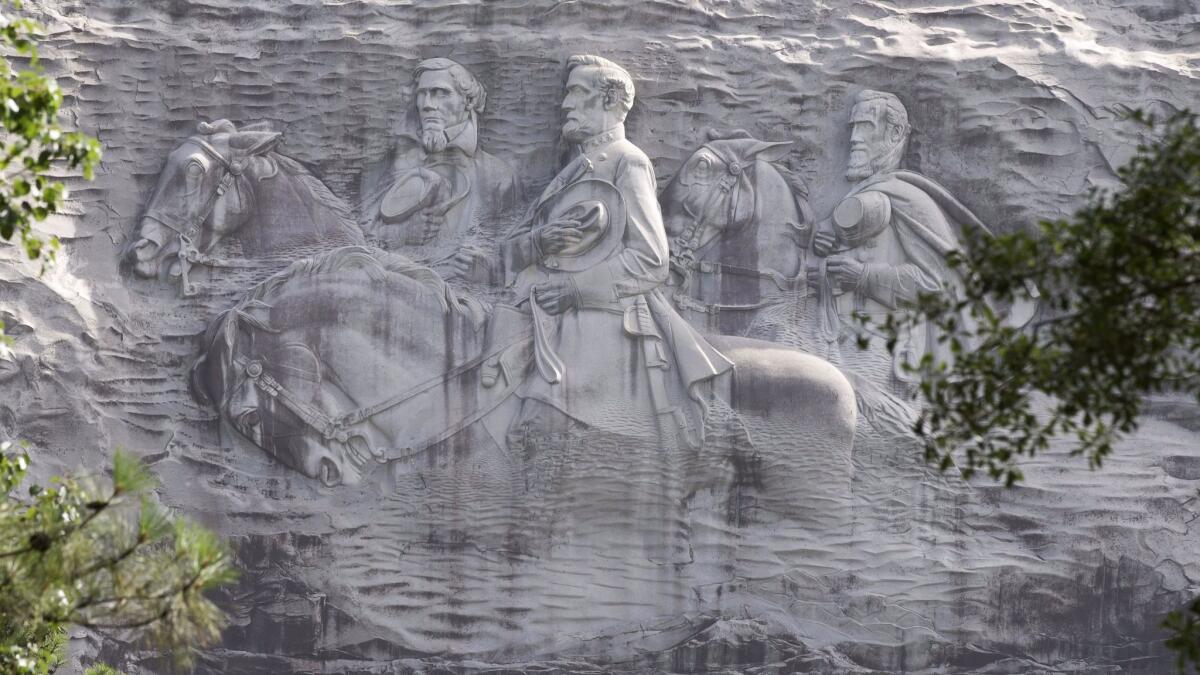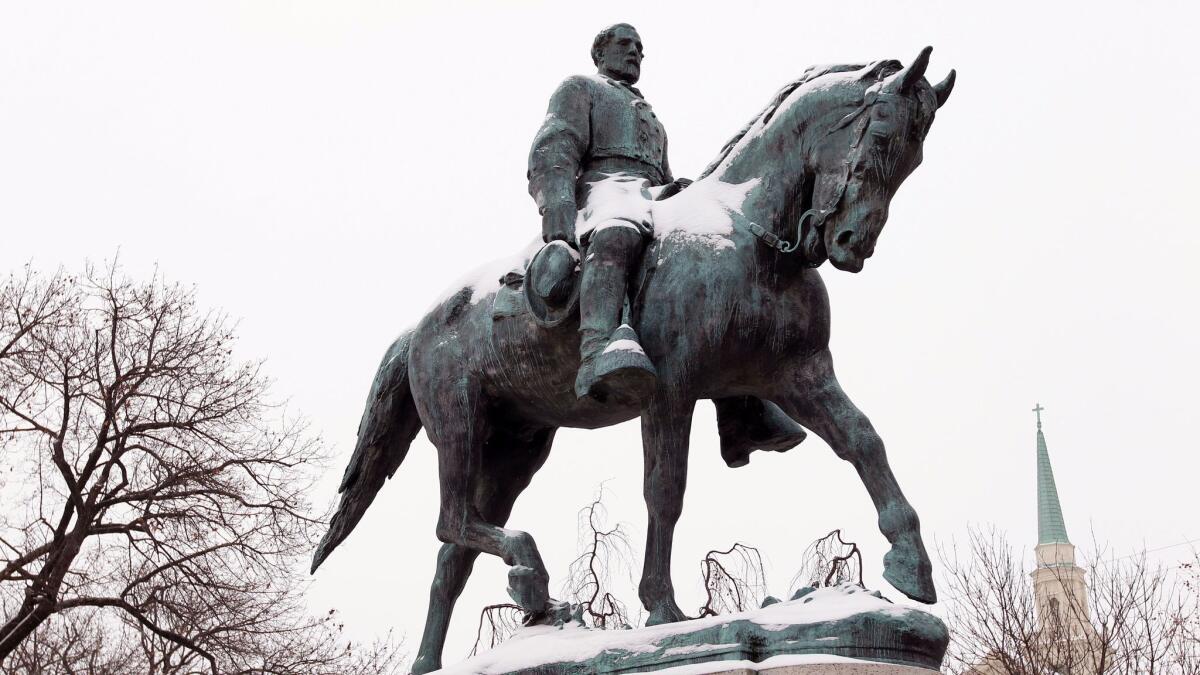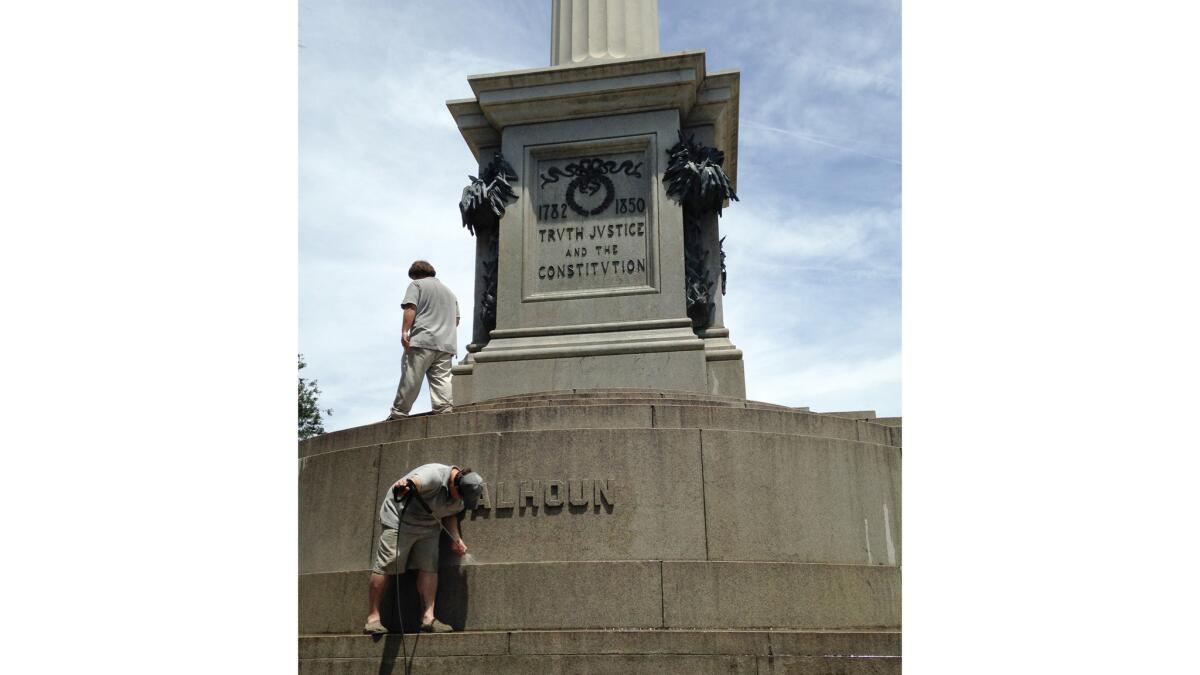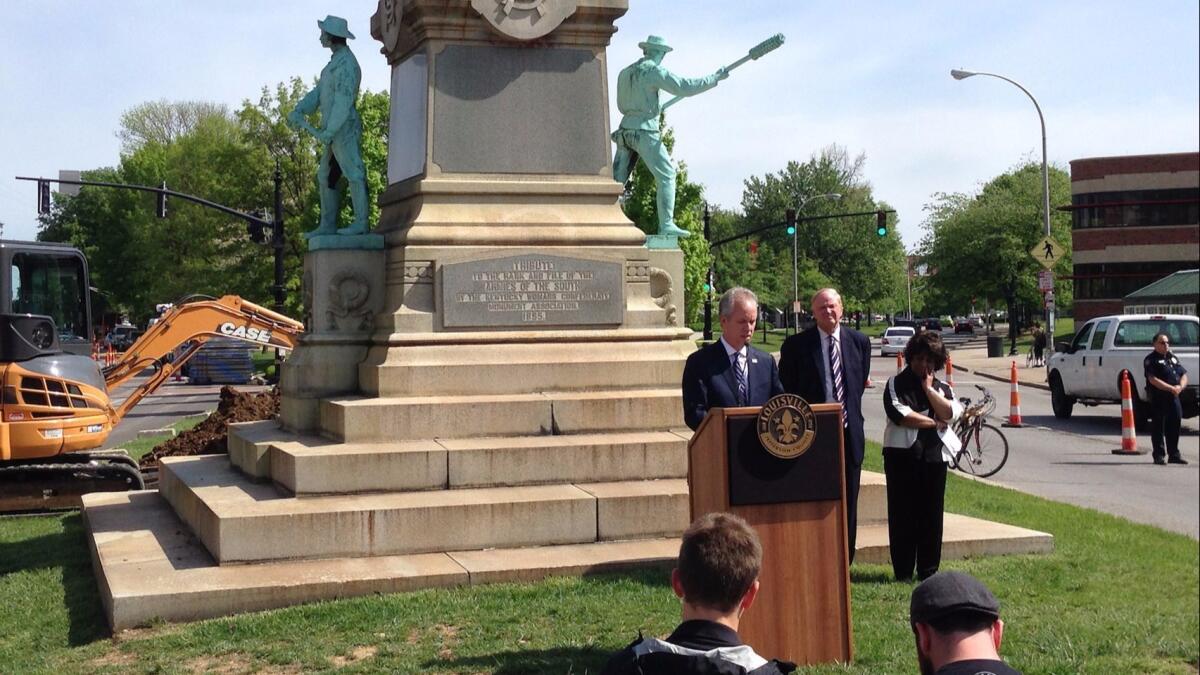New Orleans is tearing down its Confederate monuments, but the South has plenty of others

New Orleans on Monday became the latest of a growing number of Deep South cities to purge its public space of Civil War-era memorials that some say are historically significant and others dismiss as offensive relics of white supremacy.
After drilling into the top of the Battle of Liberty Place obelisk — a marble monument that celebrates the 1874 uprising of a white supremacist militia against Louisiana’s Reconstruction state government — workers in bulletproof vests and masks slowly took the structure apart.
The city also plans to remove statues of three Confederate leaders — Robert E. Lee, Jefferson Davis and P.G.T. Beauregard — after months of vigorous protest from historical preservation and Confederate groups who say the city is sanitizing its history.
“The removal of these statues sends a clear and unequivocal message to the people of New Orleans and the nation: New Orleans celebrates our diversity, inclusion and tolerance,” Mayor Mitch Landrieu said in a statement, adding that city officials would seek to place the monuments in a museum.
“This is not about politics, blame or retaliation. This is not a naive quest to solve all our problems at once,” he said. “This is about showing the whole world that we as a city and as a people are able to acknowledge, understand, reconcile and, most importantly, choose a better future.”
Debate over the future of Confederate memorials and symbols has become particularly intense across the South after the June 2015 massacre of nine black worshipers in a Charleston, S.C., church by a young white supremacist, Dylann Roof.
More than 700 Confederate monuments and statues are scattered on public property across the country, with nearly 300 of those in Virginia, Georgia and North Carolina, according to a recent report by the Southern Poverty Law Center. Here are five monuments that have been the subject of especially heated controversy:
Confederate Memorial Carving, Stone Mountain, Ga.

The Stone Mountain Confederate memorial — a vast carving of Jefferson Davis, Robert E. Lee and Thomas J. "Stonewall" Jackson on horseback — is the largest and most epic memorial to the Confederacy. The entire carved surface is larger than a football field.
Etched on a granite mountain outcrop about 15 miles outside downtown Atlanta, on a site where the Ku Klux Klan once gathered, the carving towers 400 feet off the ground and took nearly half a century to complete.
The park's memorial status is protected by Georgia law, yet the carving came under attack in 2015 when a Georgia NAACP leader called for the sculpture to be sandblasted, and the Atlanta City Council passed a resolution asking Gov.
Amid the controversy, park officials considered building a "Freedom Bell" honoring King atop the mountain, celebrating the line "Let freedom ring from Stone Mountain of Georgia" from the civil rights leader's famous 1963 "I Have a Dream" speech. Yet the proposal faced opposition from Confederate history groups and the civil rights group that King founded, the Southern Christian Leadership Conference.
Robert E. Lee statue, Charlottesville, Va.

The City Council of Charlottesville is facing a lawsuit after it voted in February to remove a bronze sculpture of Confederate Gen. Robert E. Lee astride his horse, Traveler, from the center of Lee Park.
The nearly century-old statue, commissioned in 1917, was the work of two renowned artists: Henry Shrady, a New York sculptor known for his Ulysses S. Grant Memorial outside the U.S. Capitol in Washington, and Leo Lentelli, an Italian sculptor known for his bas-reliefs on the International Building at Rockefeller Center.
Toward the end of last year, a city-appointed commission recommended the sculpture remain in the park on the condition that its context be transformed with accurate historical information and a new design. Yet city officials ruled against such a compromise, voting 3 to 2 to remove the symbol of the controversial hero of the “Lost Cause of the Confederacy.”
A month later, the Monument Fund, a division of the Sons of Confederate Veterans, and nearly a dozen private citizens filed a complaint in Charlottesville Circuit Court, arguing that the removal of the sculpture violated a state law that protects war memorials. They are also seeking damages against the city and the individual City Council members who voted for removing the statue, arguing they acted in a “grossly negligent, reckless, willful, wanton and intentional manner.”
In the meantime, the city has pressed on. Last week, the City Council voted to move forward in its efforts to sell the statue, requesting bids from museums, educational institutions and nonprofits.
John C. Calhoun monument, Charleston, S.C.

For more than 120 years, a bronze statue of John C. Calhoun has towered above Marion Square, sternly peering down on historic downtown Charleston with one hand on his hip and the other clutching a scroll.
The South Carolina native, who was a strong proponent of slavery and served as the seventh vice president of the United States, stands atop a giant column just blocks away from the Emanuel African Methodist Episcopal Church. Thousands passed below him as they paid respects to the Rev. Clementa Pinckney and eight African American parishioners who were shot to death by Roof at a Bible study class.
Just days after the massacre, the word “racist” was scrawled in red paint below Calhoun’s name. “And slavery” was added to an inscription reading “Truth Justice and the Constitution.”
Calhoun died 11 years before the Civil War began, yet critics point out that he promoted the concept of states’ rights and the South’s secession from the Union.
“He provided the intellectual scaffolding that rationalized slavery, suppressed freedom of speech and legitimized secession,” sociologist and historian James W. Loewen wrote in a Charleston Post and Courier article calling on the city to move the statue or at least erect a historical marker that offered more context.
The city quickly cleaned up the graffiti, as well as that of a nearby Confederate monument that was vandalized with messages that included "
Nathan Bedford Forrest statue, Memphis, Tenn.

The statue of Nathan Bedford Forrest, a Confederate lieutenant general and an early leader of the Ku Klux Klan, has long been unpopular in the mostly African American city of Memphis.
Towering over a downtown park, the heroic bronze statue depicts the slave trader astride his favorite horse. Underneath, a marble base contains the remains of Forrest and his wife.
“There was no element of discord in either service or celebration,” the Memphis Commercial Appeal reported as the statue was unveiled in 1905. “As the parting flags revealed the heroic figure of the wizard of the saddle, a vast crowd gave voice to loud cheers…. The South's great hero received from the hands of a grateful public loyal honors well and honestly earned.”
At least twice over the last two years, the monument has been vandalized, with "Black Lives Matter" scrawled over the marble in red spray paint.
In 2015, the Memphis City Council voted to remove the statue, along with the remains of Forrest and his wife. Yet the city has been thwarted by a Tennessee law that prevents cities or counties from relocating or otherwise disturbing war memorials on public properties. Last October, the Tennessee Historical Commission denied the City Council's application for a waiver that would let it relocate the monument.
Memphis Mayor Jim Strickland has vowed to explore other options to remove the statue.
Confederate memorial, Brandenburg, Ky. (formerly in Louisville, Ky.)

After years of debate, a more than 120-year-old Louisville monument honoring Confederate soldiers was dismantled from near the University of Louisville at the end of last year and moved to a nearby town to become part of a historic Civil War site.
The move was a compromise of sorts. Earlier in 2016, Mayor Greg Fischer and University of Louisville President James Ramsey ignited a firestorm of protest when they announced that the monument would be removed and held in storage until a new location was selected.
The monument, which depicts two bronze Confederate soldiers on each side of a 70-foot granite tower holding a third soldier, was erected in 1895 by the Kentucky Woman’s Confederate Monument Assn. to commemorate Kentuckians who fought and died for the Confederacy. In recent years, community activists called for the monument to be removed from such a prominent location.
After dismantling and removing the structure, workers restored the monument about 40 miles southwest in Brandenburg, which hosts a biennial Civil War reenactment.
“This new location provides an opportunity to remember and respect our history in a more proper context,” Fischer said in a statement. “And it’s close enough that Louisvillians can visit.”
Jarvie is a special correspondent.
ALSO
A proposed statue with a Chinese face sparks resistance and debate in Monterey Park
Neo-Nazi website unleashed Internet trolls against a Jewish woman, lawsuit says
Trump promised a border wall. Now these Texans worry the government will take their land
Start your day right
Sign up for Essential California for news, features and recommendations from the L.A. Times and beyond in your inbox six days a week.
You may occasionally receive promotional content from the Los Angeles Times.




